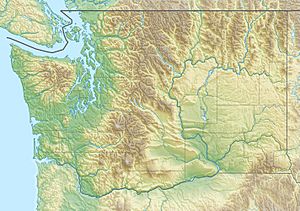Pysht River facts for kids
Quick facts for kids Pysht River |
|
|---|---|
|
Location of the mouth of the Pysht River in Washington
|
|
| Country | United States |
| State | Washington |
| County | Clallam |
| Physical characteristics | |
| Main source | Olympic Mountains 1,350 ft (410 m) 48°9′49″N 124°16′13″W / 48.16361°N 124.27028°W |
| River mouth | Strait of Juan de Fuca 0 ft (0 m) 48°12′15″N 124°6′16″W / 48.20417°N 124.10444°W |
| Length | 16.3 mi (26.2 km) |
| Basin features | |
| Basin size | 54 sq mi (140 km2) |
The Pysht River (pronounced PISHT) is a river in the United States state of Washington. It starts in the Olympic Mountains on the Olympic Peninsula. The river flows north and eventually empties into the Strait of Juan de Fuca.
The Pysht River and the nearby Hoko River are the two biggest rivers flowing into the southwestern part of the Strait of Juan de Fuca. The land around the Pysht River, called its watershed, is mostly used for growing trees for wood. About 98% of the area is for commercial forestry. Most of the trees have been cut down at least once. Many of the trees are less than 30 years old. The higher parts of the watershed are owned by the United States Forest Service. The lower parts are mostly owned by two large timber companies.
The name "Pysht" comes from the Clallam language. It might mean "against the wind or current."
Contents
About the Pysht River
The Pysht River begins near Ellis Mountain in the northwestern Olympic Mountains. This area is part of the Olympic National Forest. At first, it flows a short distance to the southeast. Then, it turns northeast. It leaves the national forest and the mountains. The land becomes more rolling and hilly.
Where the River Flows
The Pysht River collects water from several smaller streams. These are called tributaries. Needham Creek and Green Creek join the river less than a mile before the South Fork Pysht River. The South Fork Pysht River also starts in the northern Olympic Mountains. It flows north and west to meet the main Pysht River. Other streams that flow into the South Fork include the West Fork Pysht River, Middle Creek, and Salmonberry Creek.
After the South Fork joins, the main Pysht River flows mostly east and a little north. It goes towards the small town of Pysht near the coast. The river makes a big curve, flowing north, then east, then south, then east again. Finally, it empties into the Strait of Juan de Fuca. Two more streams, Reed Creek and Indian Creek, join the river in its last section.
The mouth of the Pysht River is just south of a piece of land sticking out into the water called Pillar Point. It is also just north of the Pillar Point Recreation Area. The river's mouth is an estuary. This means it's where the river meets the ocean, and the tides affect it. This area has many wetlands, with both forests and tidal plants.
Amazing Animals and Plants
The Pysht River is sometimes called a "cedar creek." This is because it has many bushes and snags (fallen trees). Its water often looks dark from natural plant dyes, like tea. This dark water is called "tannin stained water."
Fish in the Pysht River
The river is home to nine types of freshwater fish. Five of these are salmon and trout, and four are other kinds of fish. The non-salmon fish found here include Pacific lamprey, three-spined stickleback, and two types of sculpin: coastrange sculpin and prickly sculpin.
The salmon and trout species are very important. They include chinook salmon, coho salmon, chum salmon, sea-run coastal cutthroat trout, and steelhead. These fish are anadromous. This means they live in the ocean but swim back up the river to lay their eggs. Other fish like starry flounder, surf perches, and smelts might also live in the river's estuary.
In the past, many salmon and trout swam up the Pysht River. But their numbers have gone down a lot, especially chinook and chum salmon. It's thought that changes to their habitat caused this decline. These changes include logging, building roads and railroads, and moving logs. The large estuary is a very important place for young salmon to grow. It has improved a bit, but more work might be needed to help the fish populations recover.
Trees and Forests
Before people started cutting down trees for wood, the lower Pysht River watershed had very old, large trees. These included Sitka spruce, Douglas-fir, western hemlock, and western red cedar. There were also some deciduous trees, like red alder and big-leaf maple.
Today, almost the entire river basin is used for growing trees for wood. The trees are cut down and replanted often. Because of this, most of the trees in the area are less than 30 years old.
How People Changed the River
The Pysht River and its surrounding areas have been changed by human activities. These changes include building roads and railroads. People also built things to protect the roads, like riprap (rocks placed to prevent erosion). The river's path was changed in some places, a process called channelization.
Logging started in the early 1900s. This removed all the original old-growth forests. The Pysht River was straightened to make it easier to float logs down the river and into the estuary. People also regularly dug out the lower river, a process called dredging. The dirt and sand from dredging were often dumped into the estuary's wetlands. This was done to create more land for farming.
A network of logging railroads was built next to the main Pysht River and the South Fork Pysht. A wagon road that ran alongside the Pysht River was paved in the 1940s. It became Washington State Route 112.


